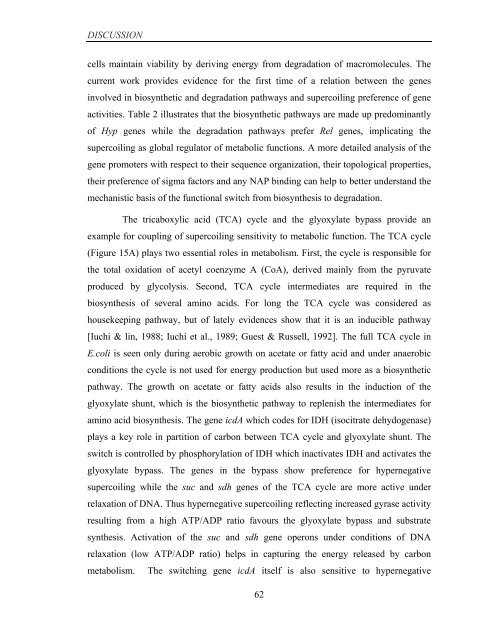Coordinated regulation of gene expression by E ... - Jacobs University
Coordinated regulation of gene expression by E ... - Jacobs University
Coordinated regulation of gene expression by E ... - Jacobs University
You also want an ePaper? Increase the reach of your titles
YUMPU automatically turns print PDFs into web optimized ePapers that Google loves.
DISCUSSION<br />
cells maintain viability <strong>by</strong> deriving energy from degradation <strong>of</strong> macromolecules. The<br />
current work provides evidence for the first time <strong>of</strong> a relation between the <strong>gene</strong>s<br />
involved in biosynthetic and degradation pathways and supercoiling preference <strong>of</strong> <strong>gene</strong><br />
activities. Table 2 illustrates that the biosynthetic pathways are made up predominantly<br />
<strong>of</strong> Hyp <strong>gene</strong>s while the degradation pathways prefer Rel <strong>gene</strong>s, implicating the<br />
supercoiling as global regulator <strong>of</strong> metabolic functions. A more detailed analysis <strong>of</strong> the<br />
<strong>gene</strong> promoters with respect to their sequence organization, their topological properties,<br />
their preference <strong>of</strong> sigma factors and any NAP binding can help to better understand the<br />
mechanistic basis <strong>of</strong> the functional switch from biosynthesis to degradation.<br />
The tricaboxylic acid (TCA) cycle and the glyoxylate <strong>by</strong>pass provide an<br />
example for coupling <strong>of</strong> supercoiling sensitivity to metabolic function. The TCA cycle<br />
(Figure 15A) plays two essential roles in metabolism. First, the cycle is responsible for<br />
the total oxidation <strong>of</strong> acetyl coenzyme A (CoA), derived mainly from the pyruvate<br />
produced <strong>by</strong> glycolysis. Second, TCA cycle intermediates are required in the<br />
biosynthesis <strong>of</strong> several amino acids. For long the TCA cycle was considered as<br />
housekeeping pathway, but <strong>of</strong> lately evidences show that it is an inducible pathway<br />
[Iuchi & lin, 1988; Iuchi et al., 1989; Guest & Russell, 1992]. The full TCA cycle in<br />
E.coli is seen only during aerobic growth on acetate or fatty acid and under anaerobic<br />
conditions the cycle is not used for energy production but used more as a biosynthetic<br />
pathway. The growth on acetate or fatty acids also results in the induction <strong>of</strong> the<br />
glyoxylate shunt, which is the biosynthetic pathway to replenish the intermediates for<br />
amino acid biosynthesis. The <strong>gene</strong> icdA which codes for IDH (isocitrate dehydogenase)<br />
plays a key role in partition <strong>of</strong> carbon between TCA cycle and glyoxylate shunt. The<br />
switch is controlled <strong>by</strong> phosphorylation <strong>of</strong> IDH which inactivates IDH and activates the<br />
glyoxylate <strong>by</strong>pass. The <strong>gene</strong>s in the <strong>by</strong>pass show preference for hypernegative<br />
supercoiling while the suc and sdh <strong>gene</strong>s <strong>of</strong> the TCA cycle are more active under<br />
relaxation <strong>of</strong> DNA. Thus hypernegative supercoiling reflecting increased gyrase activity<br />
resulting from a high ATP/ADP ratio favours the glyoxylate <strong>by</strong>pass and substrate<br />
synthesis. Activation <strong>of</strong> the suc and sdh <strong>gene</strong> operons under conditions <strong>of</strong> DNA<br />
relaxation (low ATP/ADP ratio) helps in capturing the energy released <strong>by</strong> carbon<br />
metabolism. The switching <strong>gene</strong> icdA itself is also sensitive to hypernegative<br />
62
















